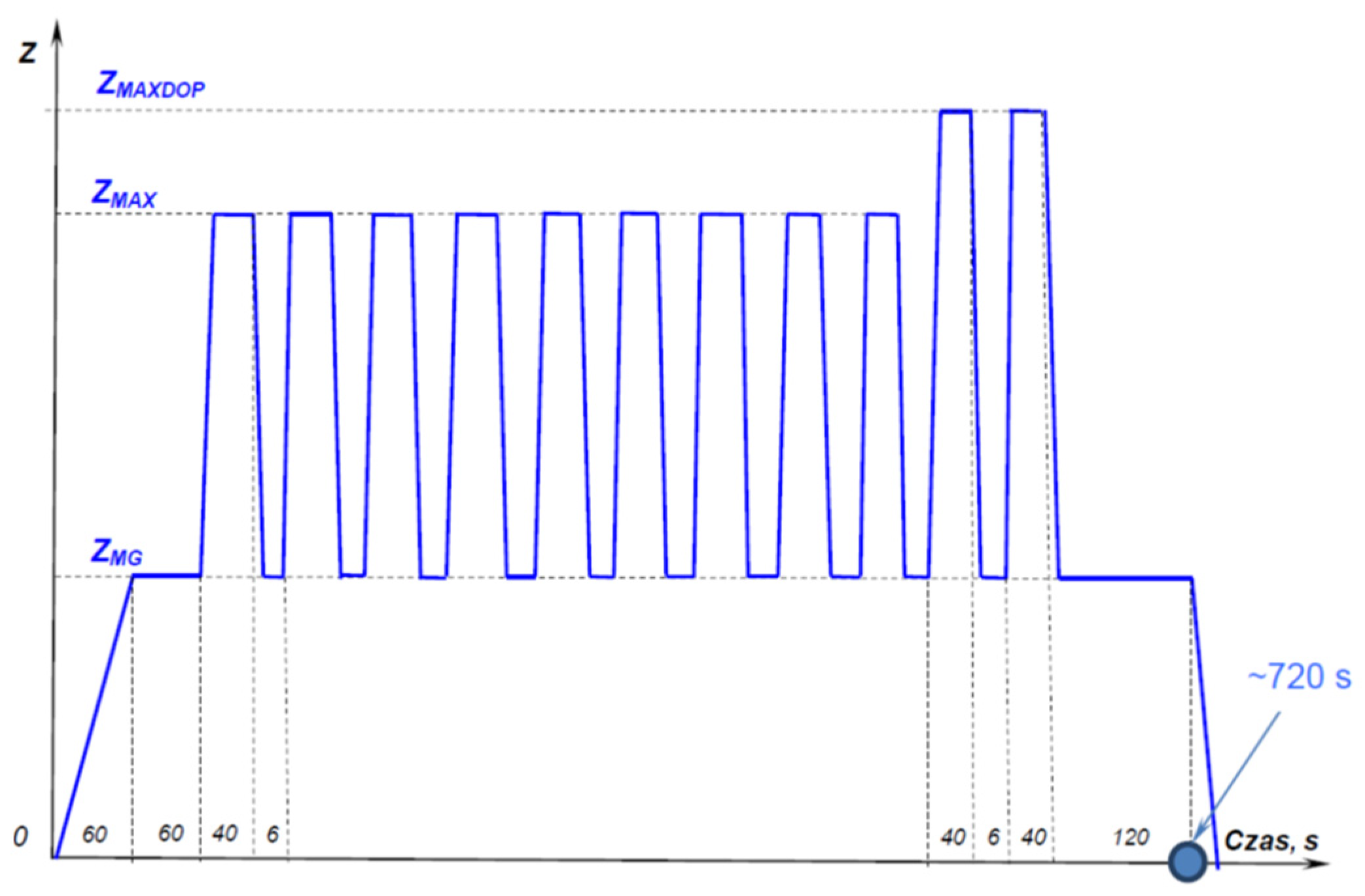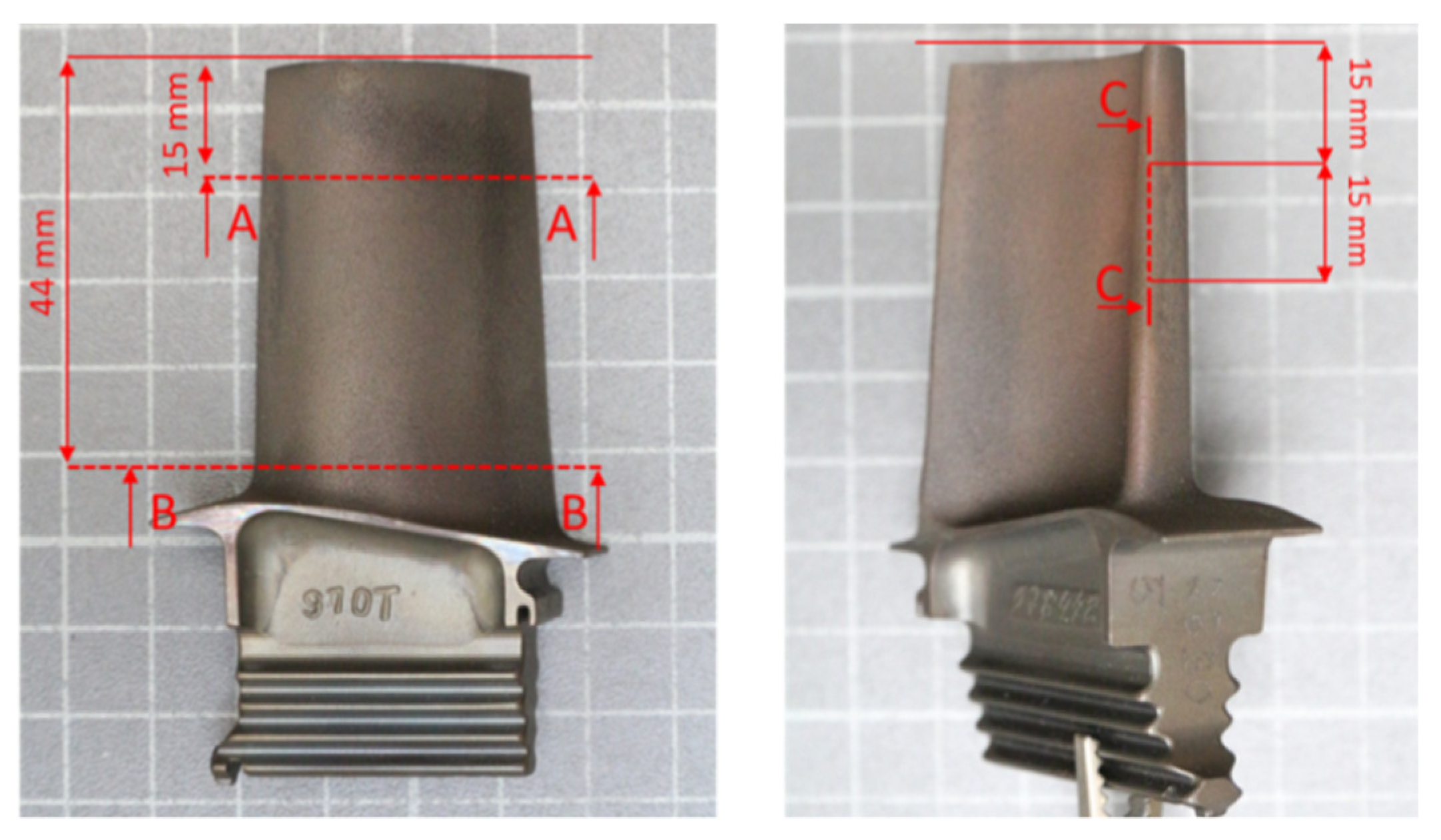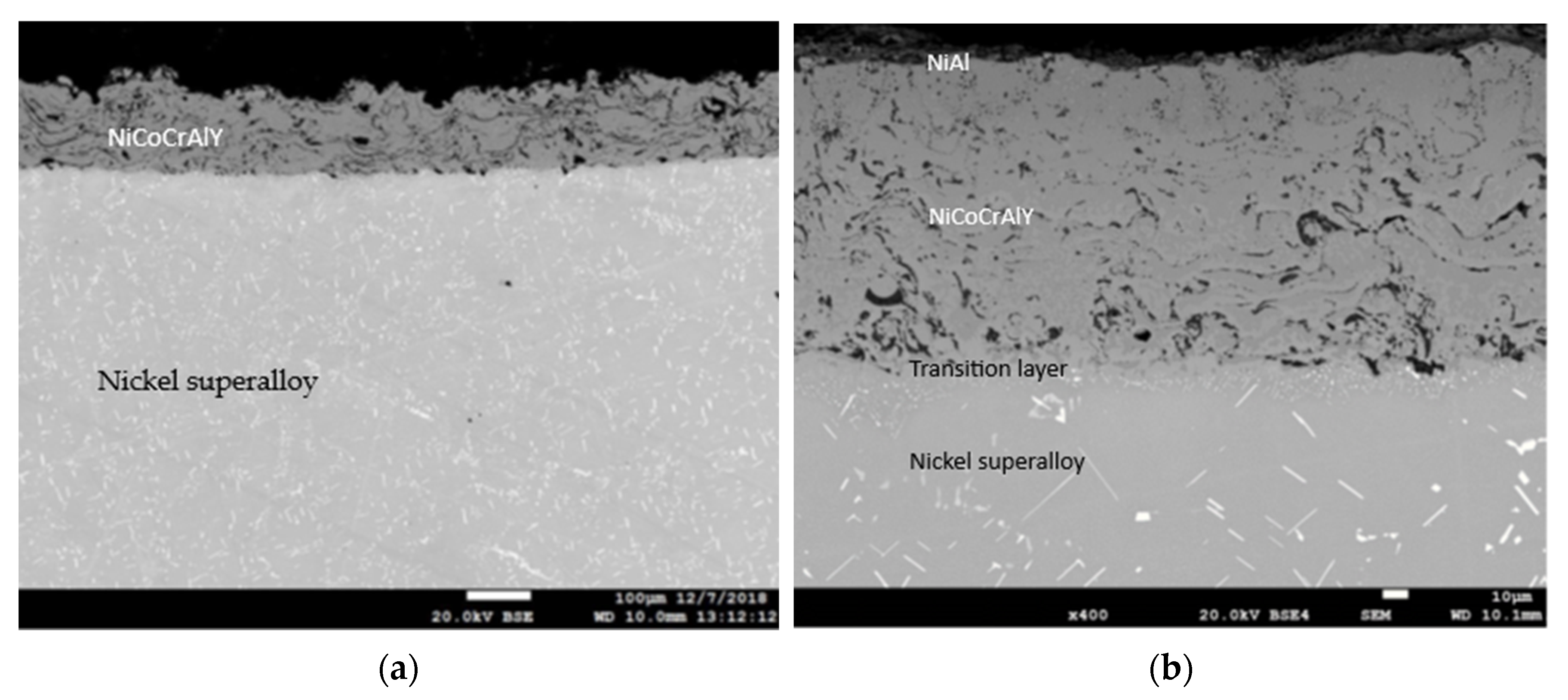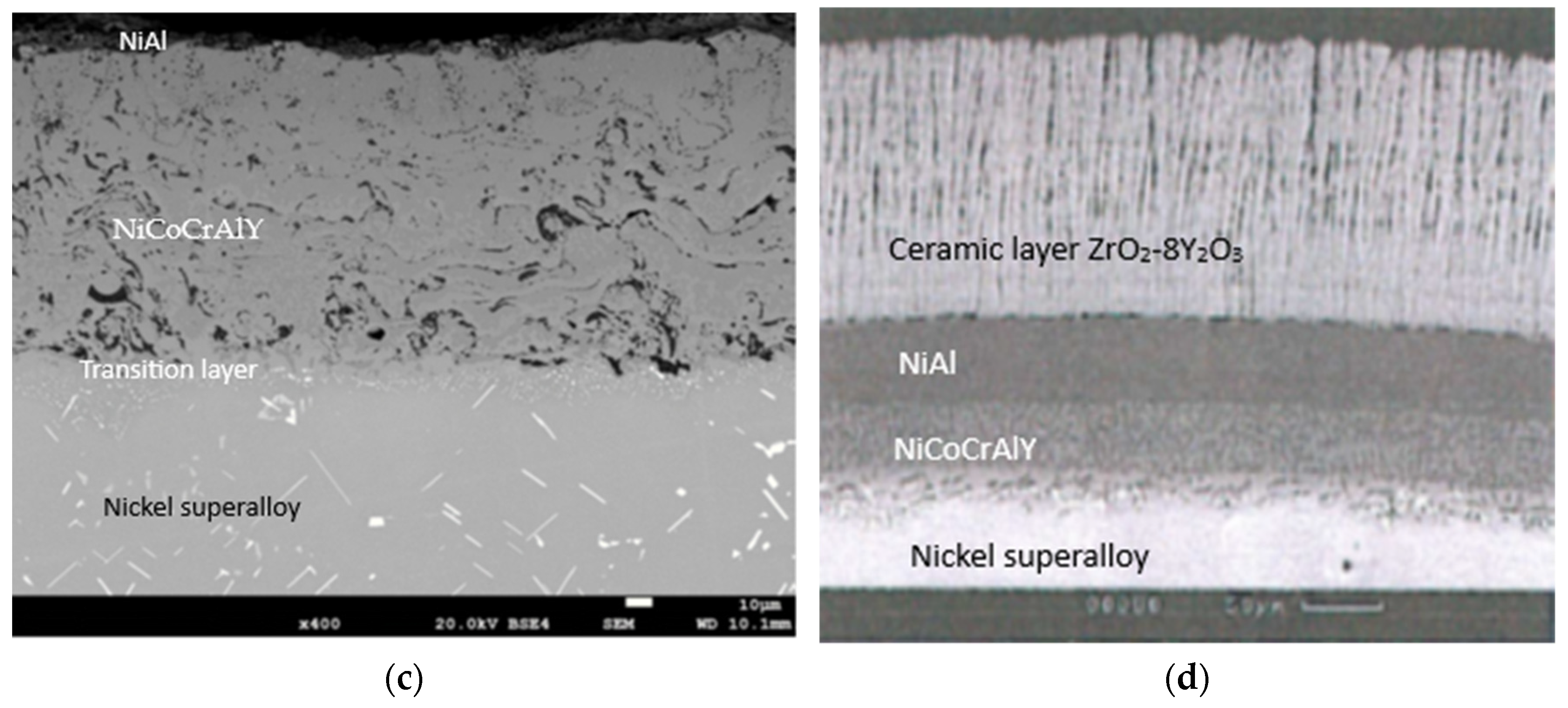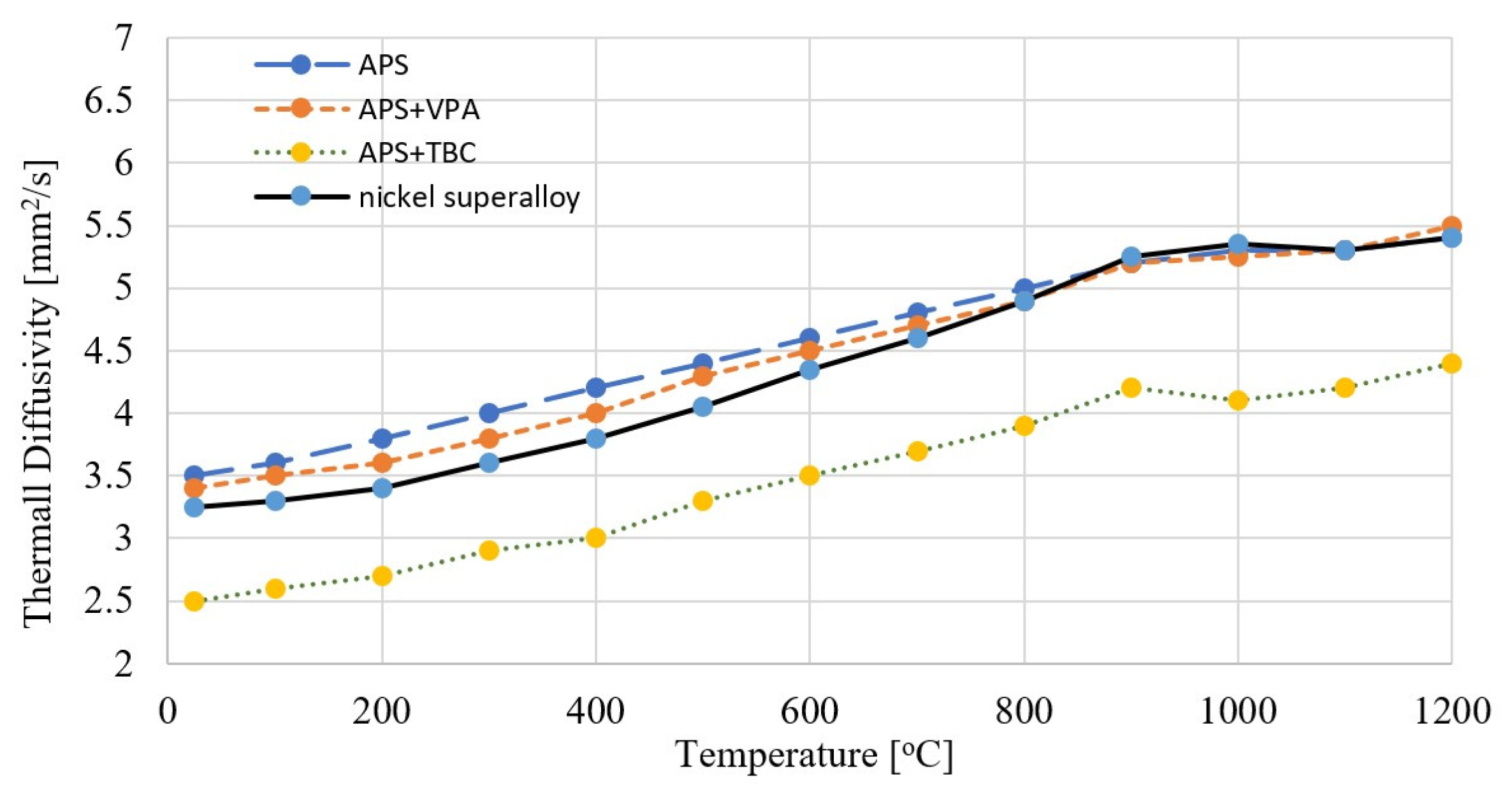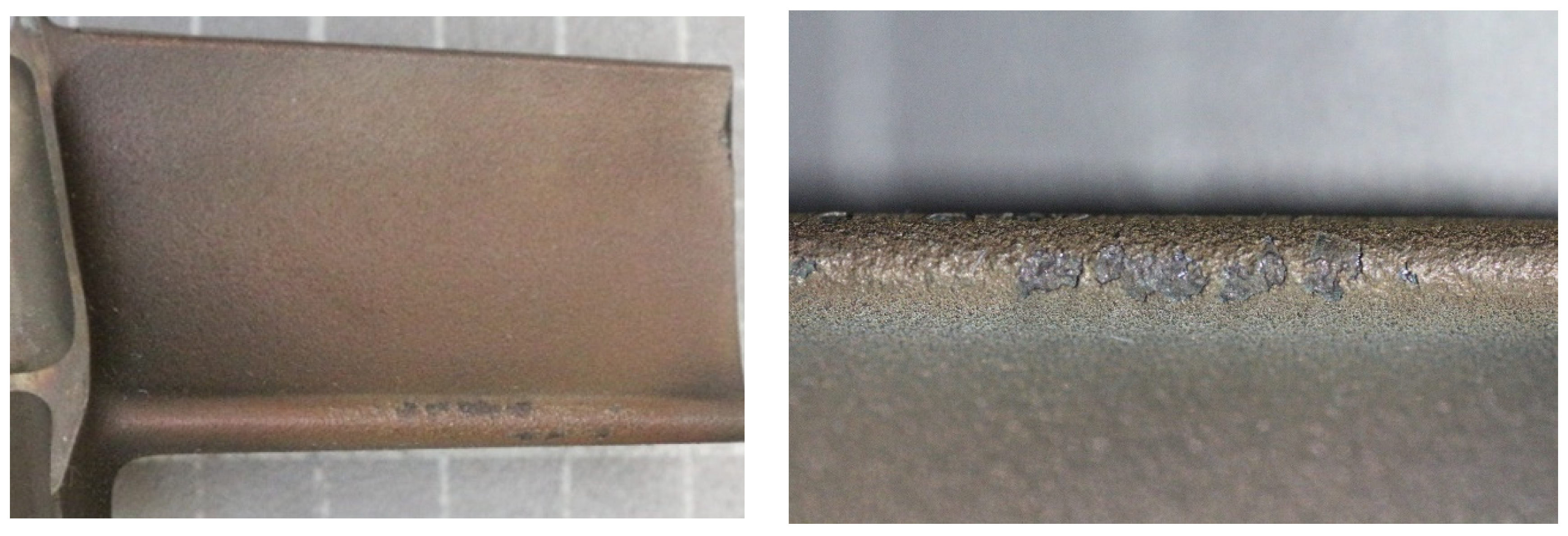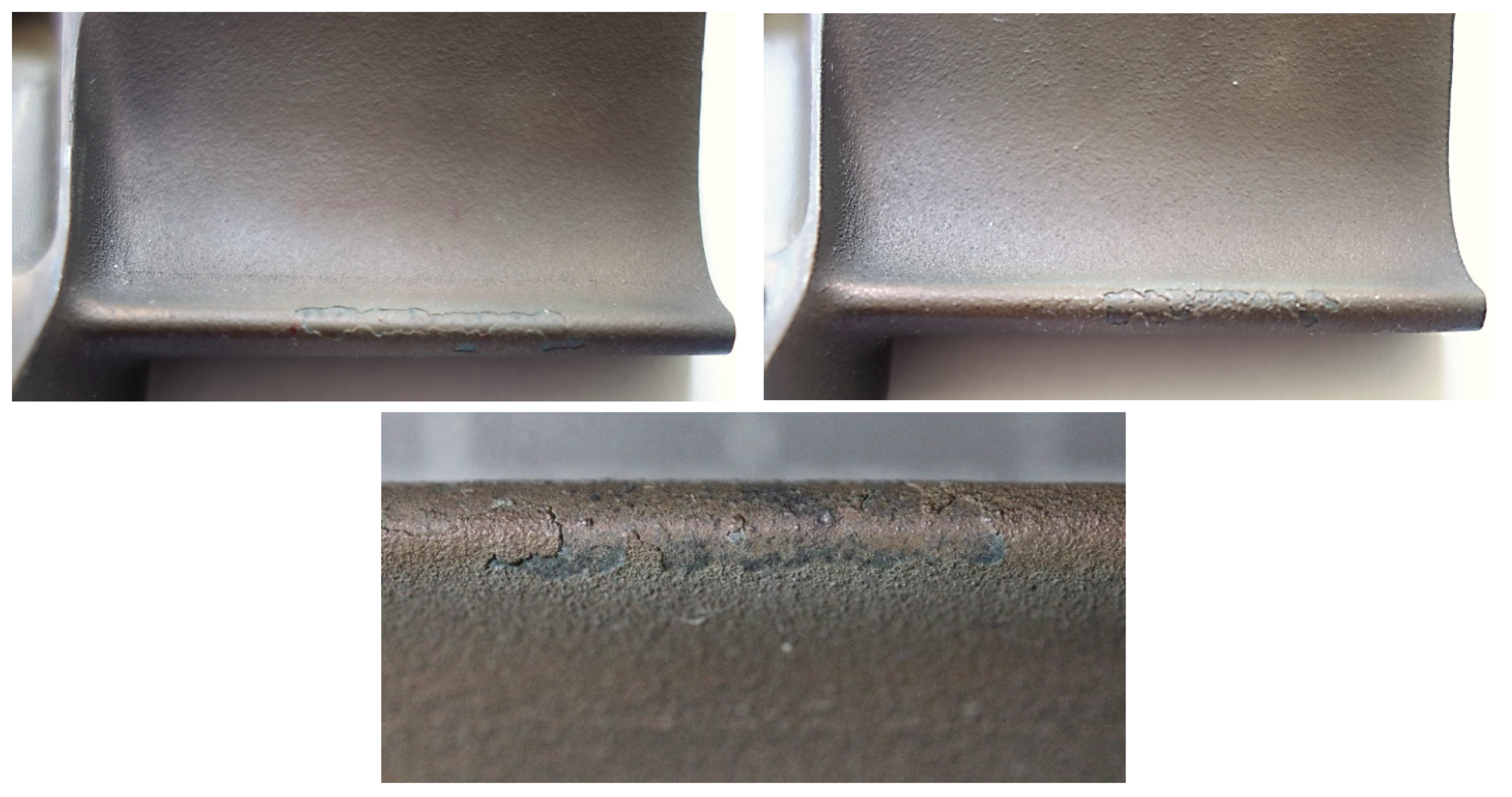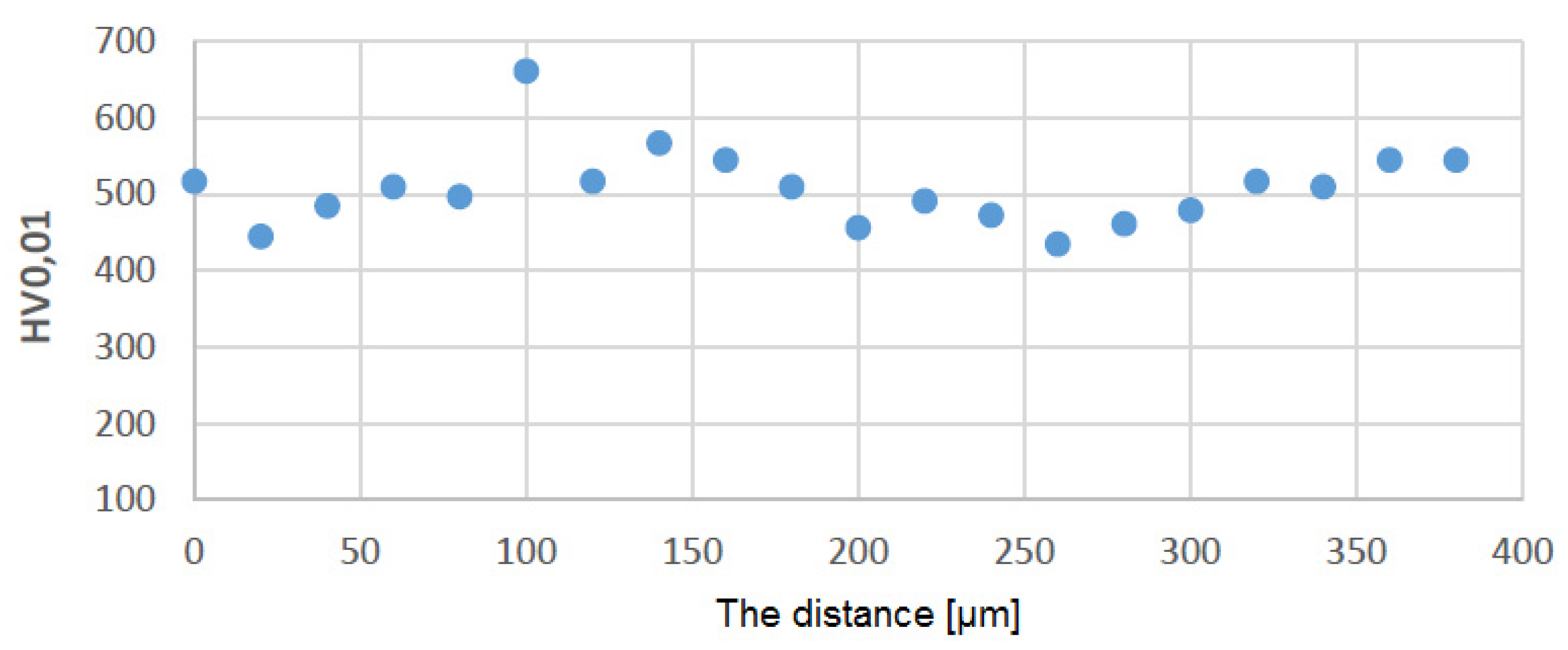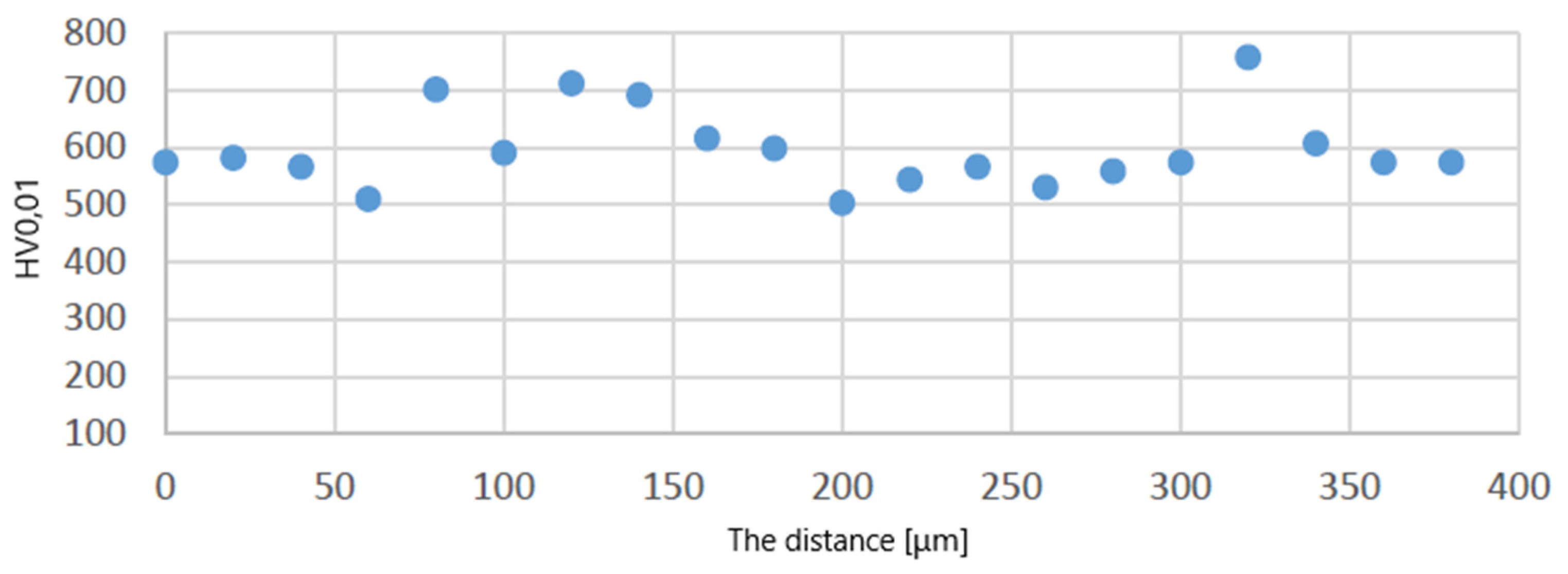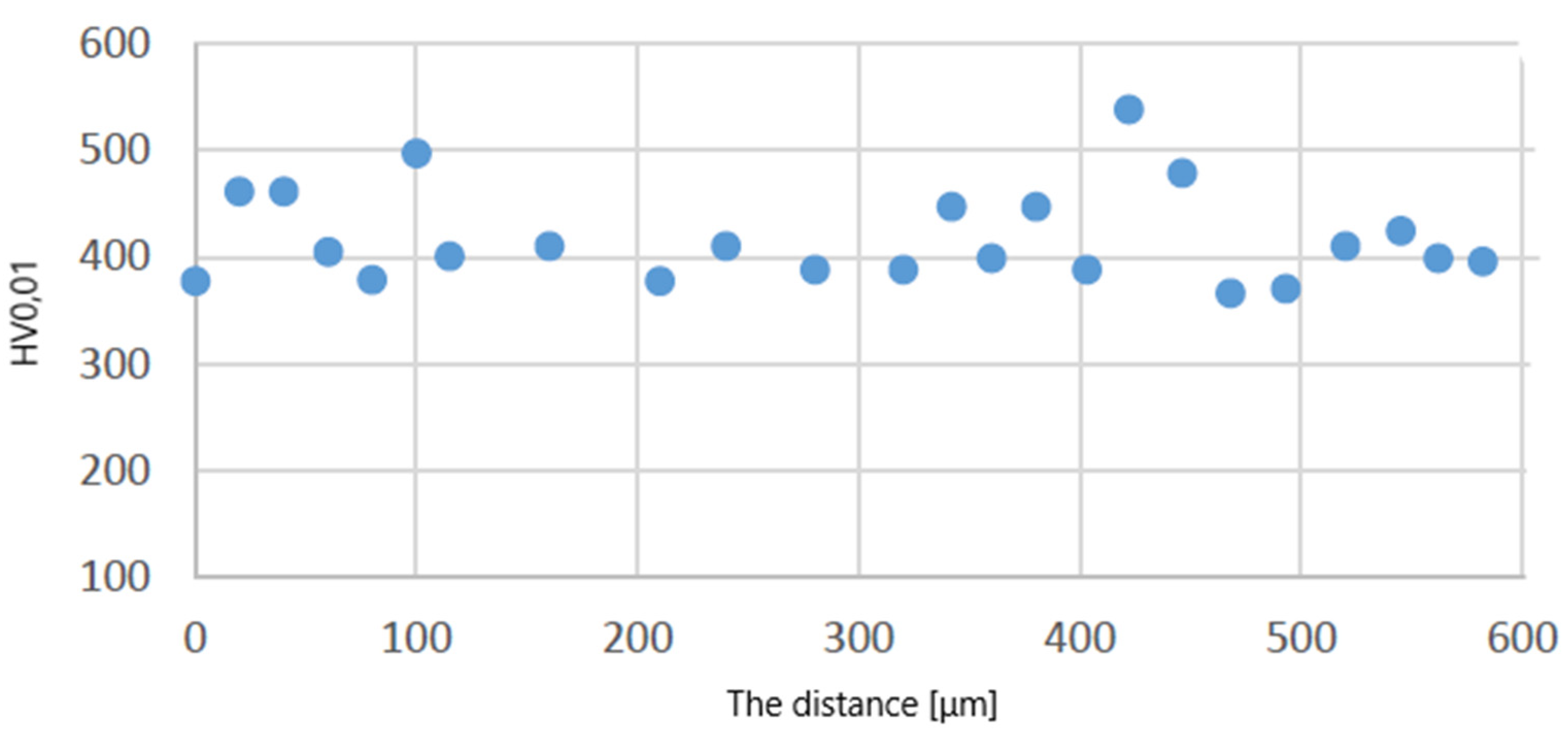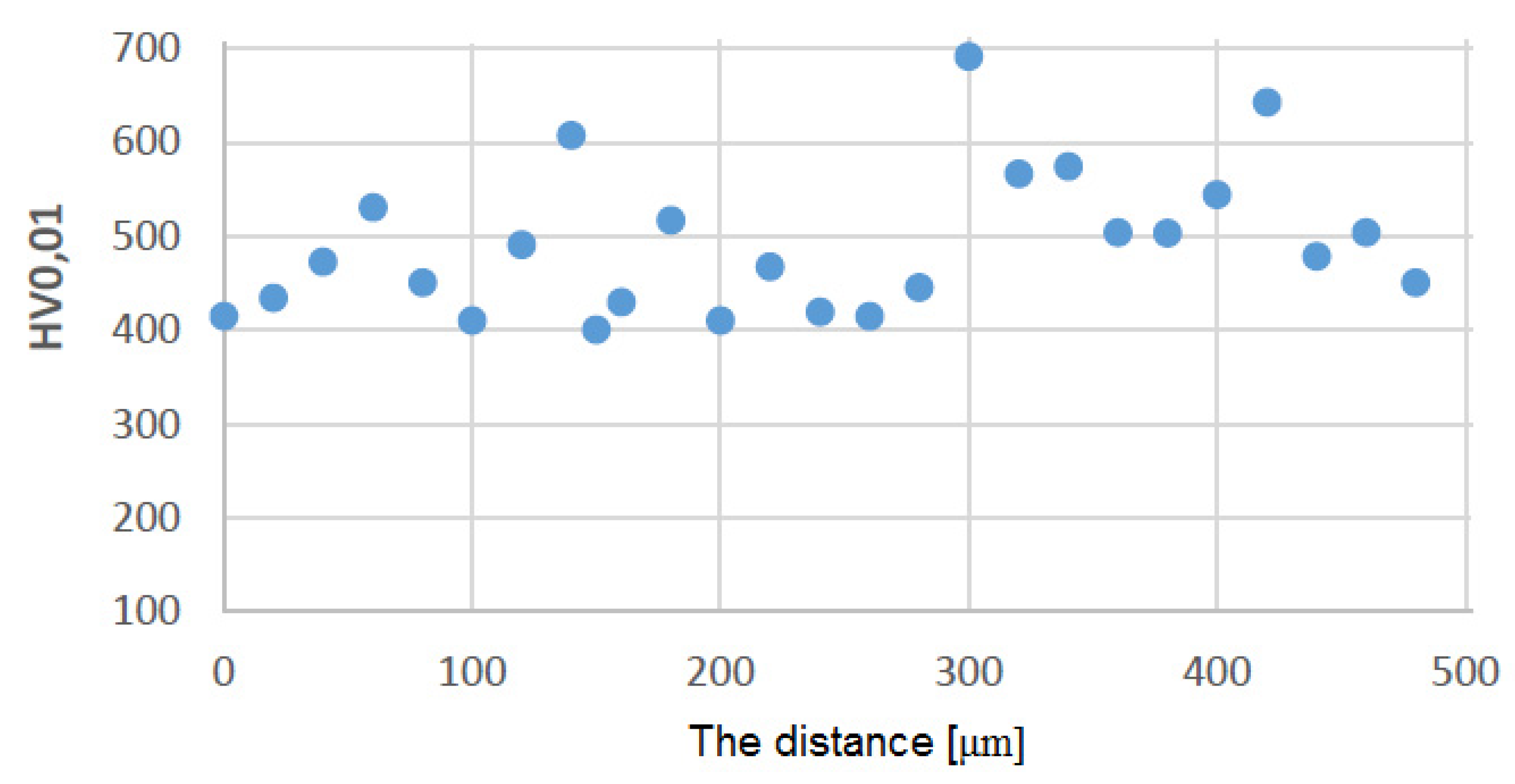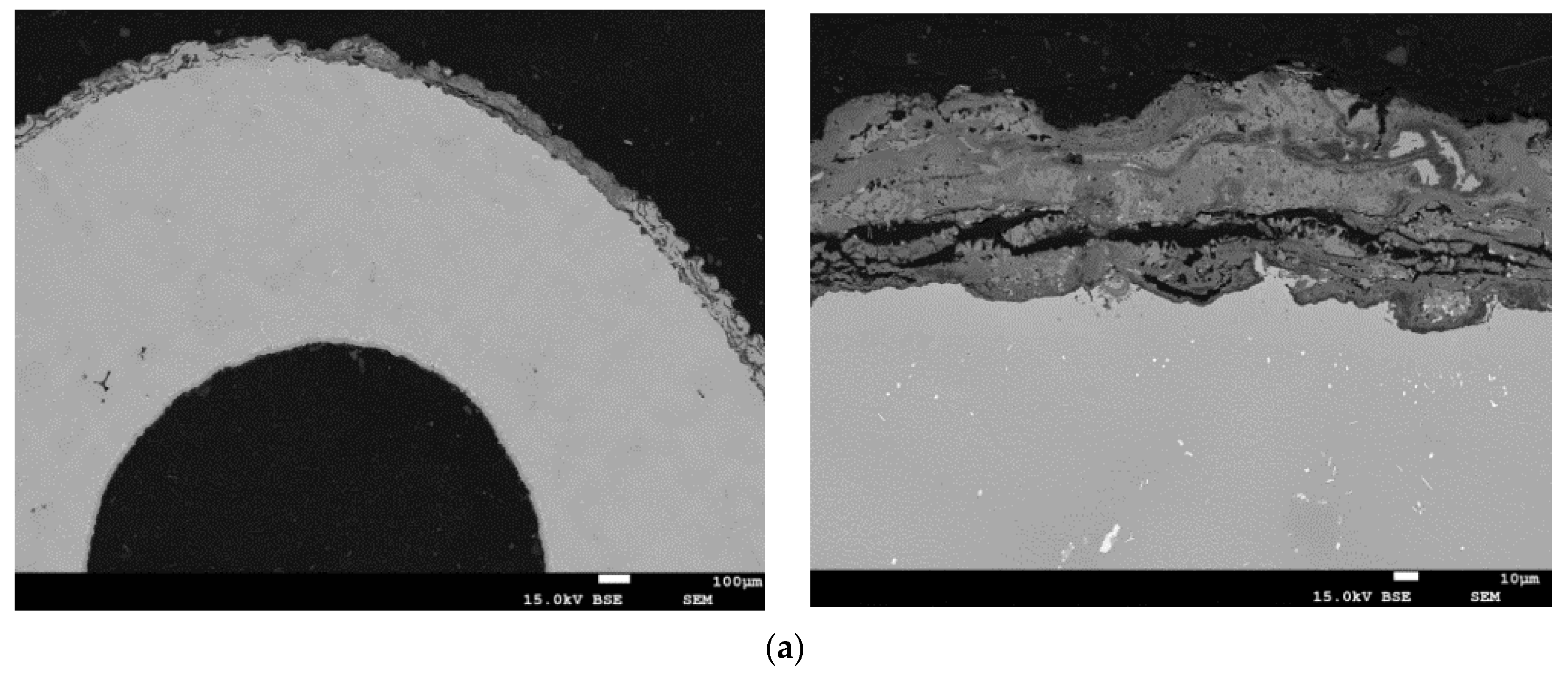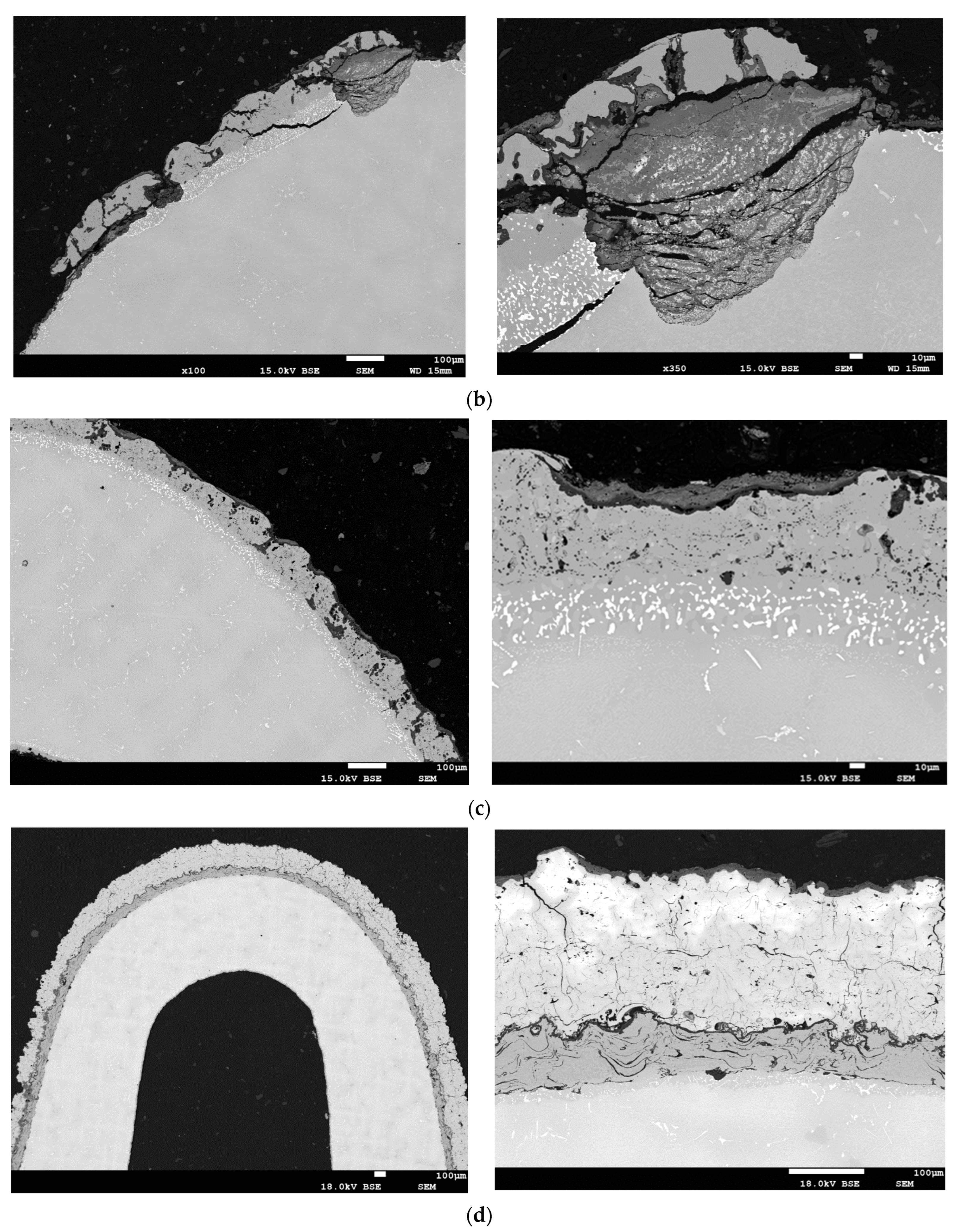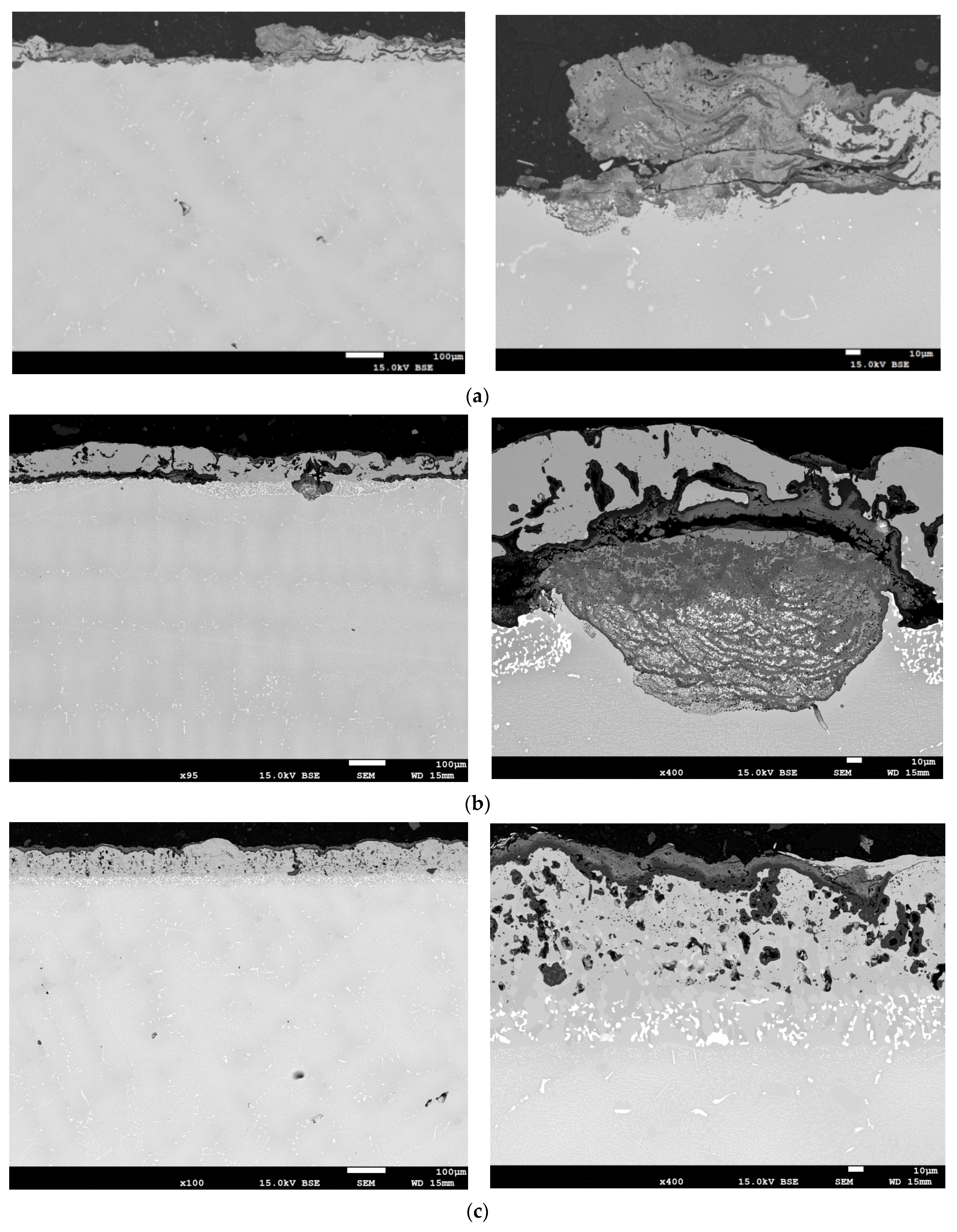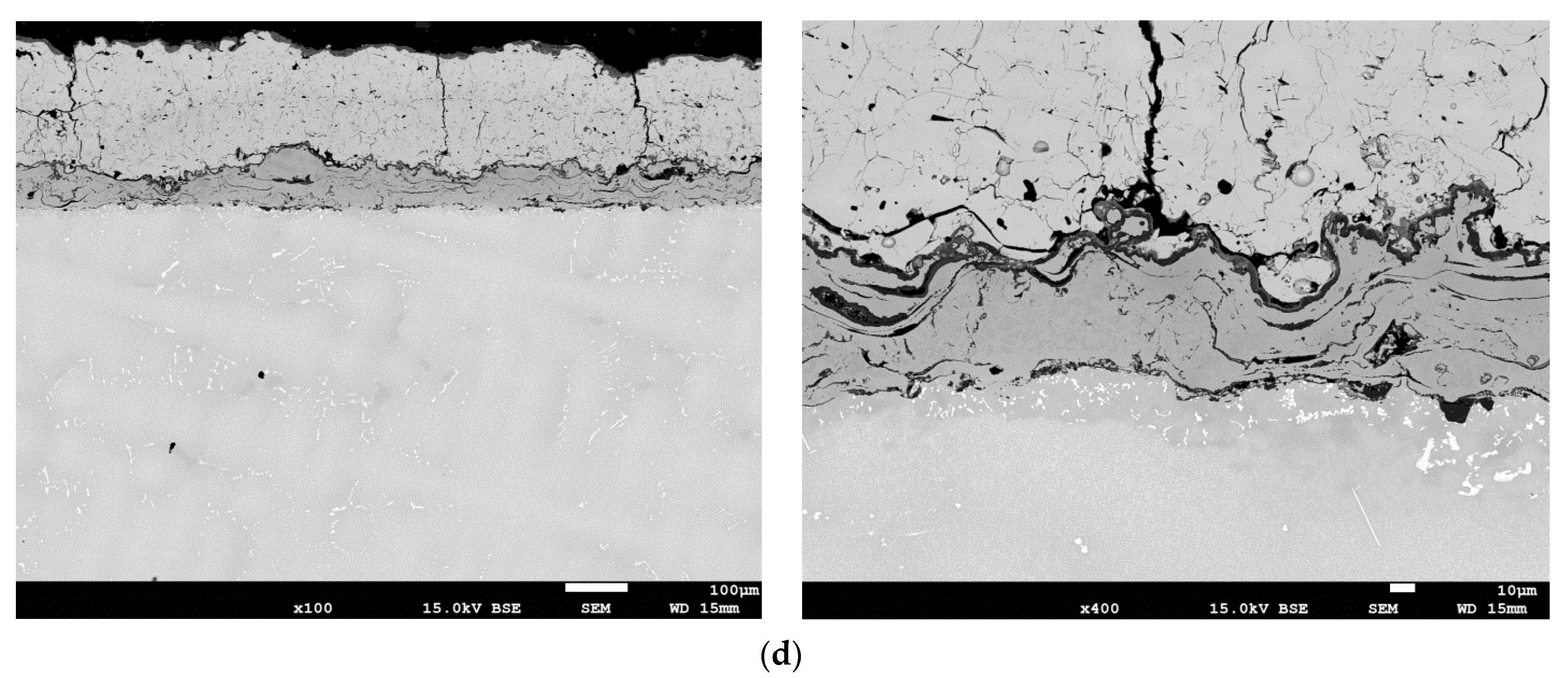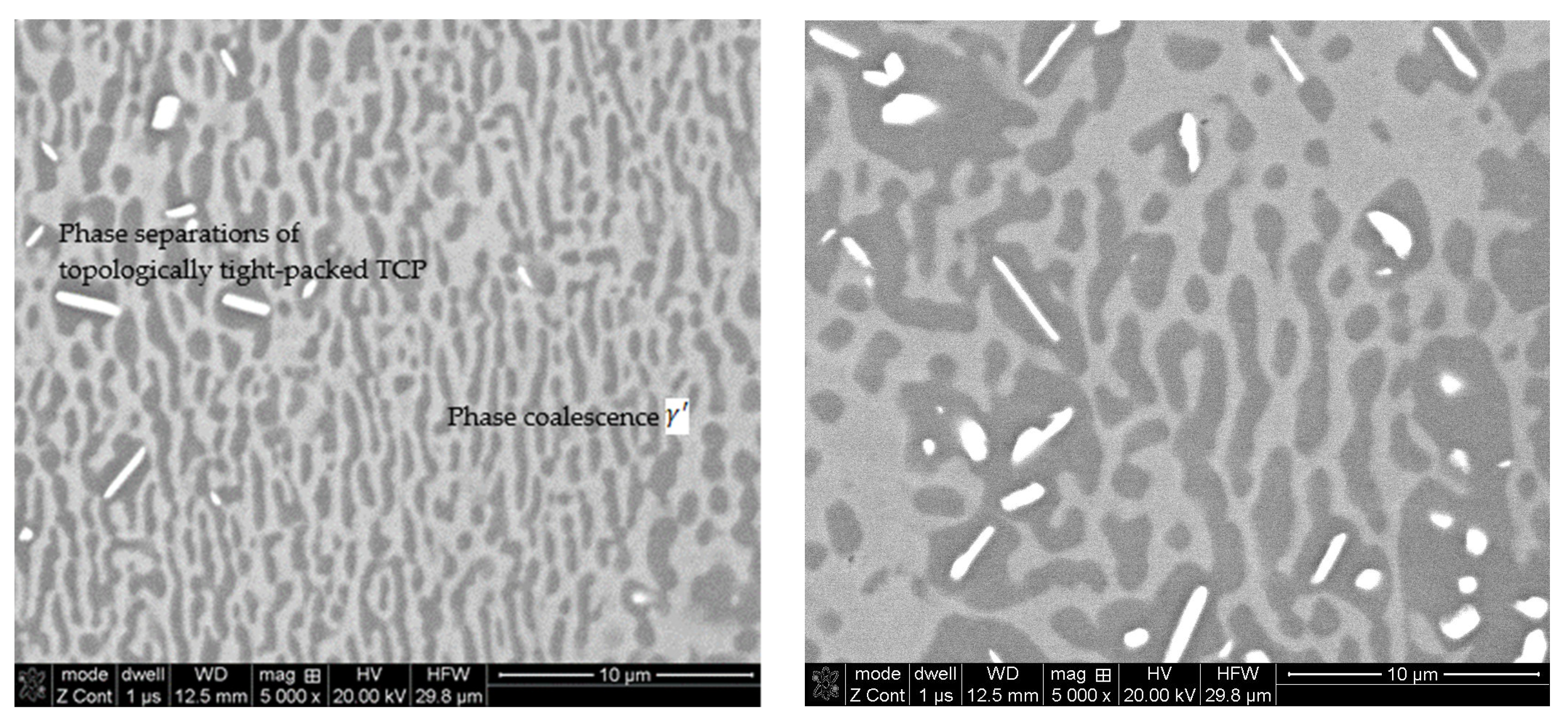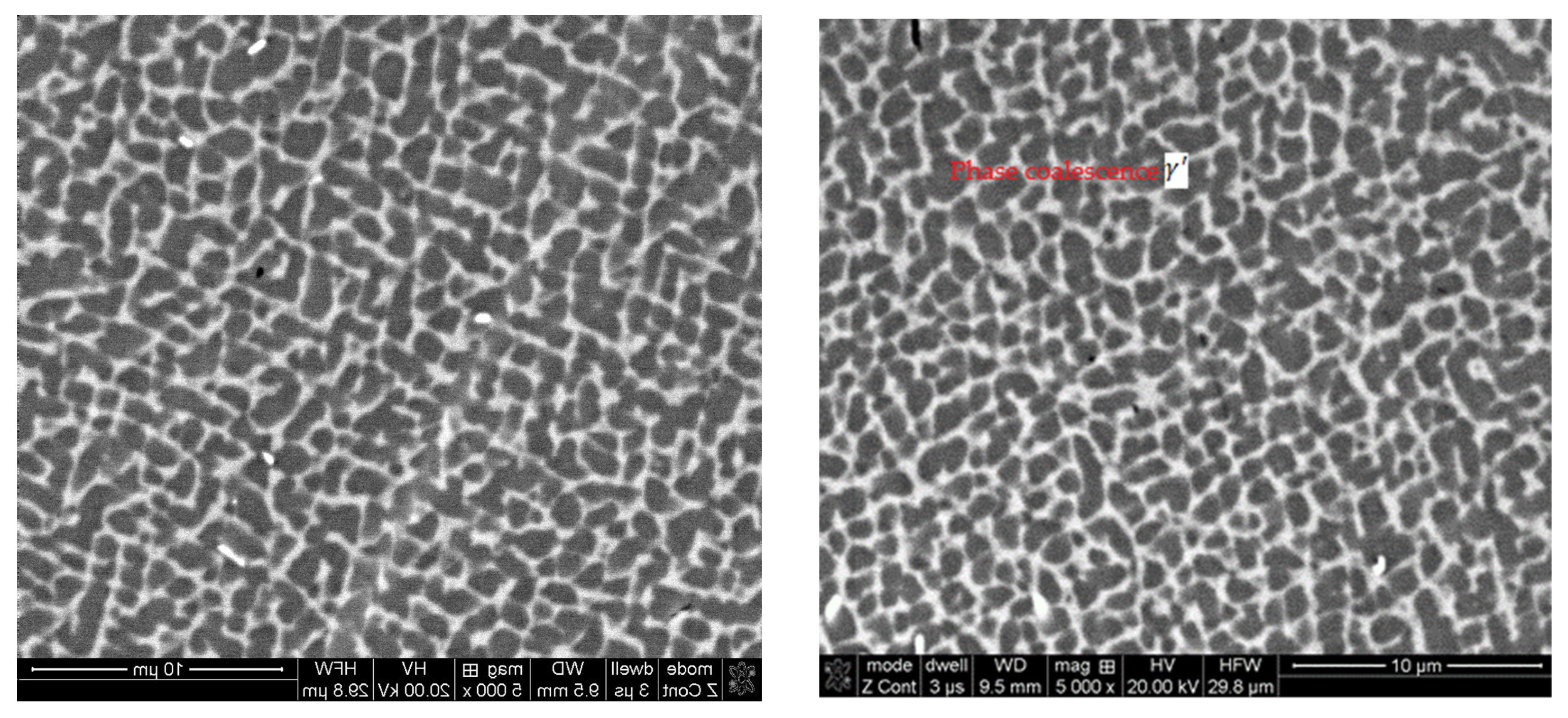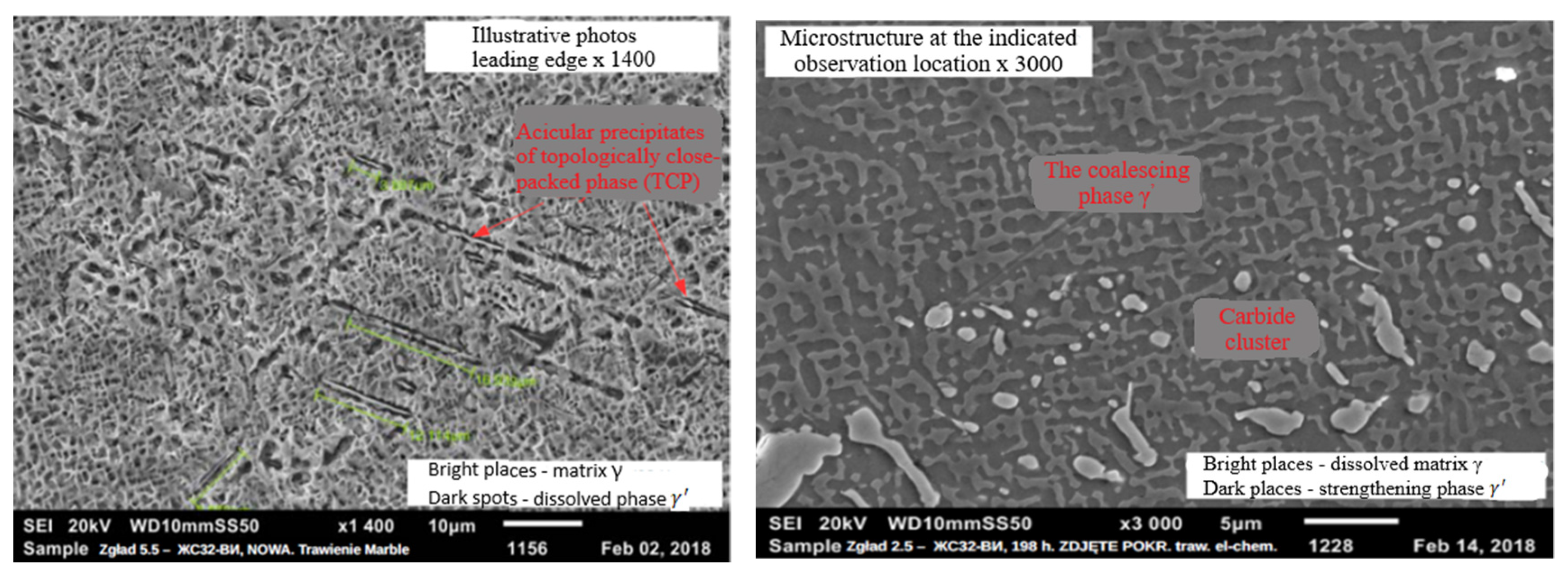1. Introduction
The maximum temperature of the gas stream in front of the turbine of a modern gas turbine engine reaches the value of 1473–1623 K. One of the engine turbine parts most exposed to this temperature are its blades. The introduction of nickel-based superalloys into the production of turbine blades, the directional and single crystallization of alloys, and the introduction of blade cooling made it possible to obtain a turbine blade operating temperature of about 1373 K. Work on heat-resistant alloys for turbine blades did not bring the desired effect in the form of an alloy combining the high mechanical properties with satisfactory resistance to high-temperature corrosion [
1,
2,
3]. The improvement of the mechanical properties of the base alloys causes the deterioration of their environmental resistance [
4,
5,
6]. Therefore, in order to achieve the required thermo-mechanical properties of the blades, their blades are covered with protective coatings. The diffusion aluminide coatings modified with elements such as chromium, platinum, yttrium, palladium, and hafnium have been used in the greatest applications [
7,
8,
9,
10]. They have been produced for many years using three methods: batch cementation, Snecma Vapor Phase Aluminizing (SVPA) [
3], and Chemical Vapor Deposition (CVD) [
9,
10]. The use of traditional aluminide coatings for the protection of turbine blades in thermally strained engines turned out to be insufficient because the boundary between the β-NiAl layer and the heat-resistant alloy of the blade core began to melt at a temperature above 1393 K [
11,
12]. One of the main problems encountered during the operation of aluminide coatings is their thermomechanical fatigue [
13,
14]. Cyclic deformations caused by temperature gradients in the blades most often lead to fatigue cracks in the shell [
15,
16].
The protective coatings used as present slow down the process of oxidation and depletion of the monocrystalline component of the substrate from alloying elements. However, they do not protect the blade walls from overheating because they do not have good insulating properties [
17,
18]. In operation, the structure of the protective coating and the blade material are often degraded. Examinations of the blades from exploitation show that they contain: oxidation of the protective coating and its diffusion interaction with the native metal, dissolution and globular coagulation of the γ’ phase in the nickel alloy, degradation of the blade wall structure, and an intensive decrease in aluminum content, which is responsible for heat resistance [
19,
20]. The above phenomena cause the formation and propagation of thermal fatigue cracks in the blade. This causes the engines to be taken out of service prematurely. This significantly increases the cost of operating the aircraft and reduces the safety of flights. The analyzes carried out by the authors of this article show that the structure and thermophysical properties of the protective coating must be adapted to the given alloy from which the blade is made [
9,
21,
22,
23]. Therefore, efforts should be made to achieve the best possible convergence of the structure and thermophysical properties of the protective coating and the base material of the blade. In recent years, work has been undertaken on the production of protective coatings with a gradient structure [
9,
24]. The basic concept of producing layers and functional gradient structures is to combine several materials in a multi-layer system so that their properties exceed those of single-component materials. While maintaining the gradient principle, the functionality of the coatings is responsible for environmental countermeasures (erosion, high-temperature corrosion, loss of adhesion, and the formation of cracks perpendicular to the blade material).
The aim of the work was to design heat-resistant protective coatings for turbine blades, and to assess their condition after an engine test under dynamometer conditions. The scope of the work included making protective coatings for turbine blades made of nickel superalloy, testing the blades on a running engine under dynamometer conditions, testing the microstructure of protective coatings after their engine test, and assessing the quality of the protective coatings obtained. The designed protective coatings on the blade of the turbine blade had a two-layer structure. The first, inner layer was an adhesive layer of the NiCoCrAlY type. NiCoCrAlY overlay coatings, unlike diffusion coatings, provide greater independence from the substrate alloy, but also greater flexibility in design because the compositions can be modified depending on the expected degradation mechanisms. Typical bond coatings contain at least four basic elements plus yttrium (Y), hafnium (Hf), and tantalum (Ta). The presence of a significant amount of Cr gives these coatings excellent corrosion resistance combined with good oxidation resistance. NiCoCrAlY coatings typically exhibit a two-phase β + γ microstructure. The presence of γ increases the ductility of the coating, thereby improving the resistance to thermal fatigue. Ni and Co added together results in better corrosion resistance. Cr provides resistance to hot corrosion, but the amount that can be added is limited by the effect it should have on the substrate and the formation of Cr-rich phases in the coating. The Al content is usually about 10%–12% by volume. NiCoCrAlY also usually contains 1% vol. by weight yttrium (Y), which improves the adhesion of the oxide layer, combines with sulfur, and prevents it from segregating into the oxide layer, which would otherwise damage its adhesion. Hafnium (Hf) additions play a similar role to that of yttrium. The addition of rhenium (Re) in NiCoCrAlY improves the isothermal or cyclic oxidation resistance and thermal cycle fatigue, and tantalum (Ta) increases the oxidation resistance. Due to the presence of a significant amount of Cr in it, it protects the base material of the blade against oxidation and high-temperature corrosion. The advantages of the NiCoCrAlY layer are that it is possible to shape the content of aluminum and chromium and other elements in it and that its properties do not depend on the chemical composition of the blade material [
22,
23,
24,
25,
26]. This layer is characterized by a low transition temperature from the brittle state to the plastic state, amounting to 473–573 K. The second layer, the outer one, was a diffusion thermal layer of the NiAl type with low thermal conductivity. Heat resistance tests carried out by Kukla et al. [
27,
28] showed that the oxidized aluminum coating is characterized by excellent durability and tightness of the protective scale, as no scale chips were observed on the surface of the tested coating. They found that the phase structure of the scale consisted mainly of NiAl and NiAl
2O
4 intermetallic phases and a stable α-Al
2O
3 oxide, which improves the corrosion resistance of nickel alloys. They found a significant improvement in the strength response of the MAR 247 nickel alloy by about 200 MPa during cyclic loading at 1173 K. They confirmed that the use of an aluminide layer can effectively protect the parent material against such processes as oxidation, corrosion, and wear. NiAl aluminide has a melting point of 1956 K [
13,
26]. The outer layer is intended for thermal protection against the high-temperature stream of aggressive fuel combustion products. In the designed coatings, the NiCoCrAlY protective layer was applied to the blade by plasma spraying (APS), and the diffusion aluminization of the protective coating (NiAl) was carried out using the non-contact gas (VPA) and slurry (SLURRY) methods. In the case of the ceramic coating, a ceramic layer was deposited on the NiCoCrAlY layer by plasma spraying (APS). In order for the ceramic coating to have a chance not to spatter during the first thermal cycle, it is important that its thermal expansion is close to the thermal expansion of the substrate. For a coating to be useful, it must also have very low thermal conductivity. Zirconium oxide (ZrO
2) stabilized with yttrium oxide (Y
2O
3) is widely used for this purpose. The addition of 5%–15% yttrium oxide stabilizes the zirconia in its high-temperature crystalline form, thus avoiding a phase transition in the operating temperature range. Zirconium oxide (ZrO
2) ceramic meets both the requirements, with a coefficient of thermal expansion of 11–13 × 10
−6 K
−1 and a thermal conductivity of approximately 2,3 W/(mK) at 1000 °C for a fully compacted material, and it can be additionally reduced by introducing porosity.
A new element of the research was the fact that blades with protective coatings were tested on a running engine under dynamometer conditions. Previous research practices consisted in annealing samples with protective coatings in an electric furnace.
2. Materials and Methods
2.1. Materials
The object of the tests were protective coatings applied to the turbine blades of the RD-33 aviation turbine engine made of nickel superalloy, the chemical composition of which is shown in
Table 1. These blades are produced in a vacuum foundry furnace using directional crystallization technology using crystalline nuclei (starting cones) to give solidifying directionally columnar grains of the correct crystallographic orientation <001> coinciding with the z axis of the blade [
29].
Amdry 386-4 coating material (Oerlikon Metco Europe GmbH Sp. z o. o. Branch in Poland, Poznań, Poland) was used to make the inner layer of the protective coating of the turbine blade, which was applied to the blades by plasma spraying (coating type NiCoCrAlYHfSi), hereinafter referred to as APS. The composition of the Amdry 386-4 coating material is shown in
Table 2. The first type of outer layer is a diffusion aluminized layer produced by the non-contact gas method (VPA), the second type was produced by a slurry method (SLURRY), and for the third one, ceramic powder METCO 204 BN-S was plasma sprayed (zirconium oxide (ZrO
2), yttrium oxide (Y
2O
3)). ZrO
2-8Y
2O
3 ceramic powder (Metco 204 BN-S, Oerlikon Balzers Coating Poland Sp. z o. o. Kedzierzyn-Kozle, Poland) had a chemical composition of ZrO
2+ 8% by weight. Y
2O
3 had a granulation range of −125 + 11 μm. Due to the large size of the powder particles, its dimensions were reduced with an average particle size of d
V50 = 4.5 μm. To reduce the size of powder particles, the ball milling process was used, where a single cartridge consisted of: (i) powder, (ii) zirconia balls, (iii) a dispersant preventing the formation of agglomerates, and (iv) ethanol as a cooling medium. The maximum thickness of the protective coating applied to the turbine blade was 160 μm (APS). In the case of a two-layer coating, the thickness of the NiCoCrAlYHfSi (APS) layer was 90–120 μm and that of the NiAl layer was 40–70 μm.
The process of producing coatings by APS plasma spraying was carried out using a Sulzer Metco MultiCoat device equipped with an F4-MB gun. The technological parameters of the NiCoCrAlYHfSi coating process are as follows: the distance between the gun nozzle and the blade: 145 mm; hydrogen flow: 14 dm3/min; argon flow: 65 dm3/min. After depositing the protective coating on the blade, it was subjected to heat treatment and shot peening. This allowed the layers of the coating to diffuse to each other, and thus improved its adhesion. The heat treatment of the coating was carried out in a vacuum oven for 4 h at a heating rate of 10 °C/min at a temperature of 1050 °C. Heat treatment was carried out in a protective atmosphere of argon. The shot peening process was performed with glass balls with a granulation of 230 mesh and a pressure of 4 bar. The protective coating called APS + VPA, APS + SLURRY, APS + TBC was made in two stages. In the first step, the coating called APS, which is described above, was made. In the second stage, in the case of the coating called APS + VPA, diffusion aluminization was performed using the VPA method with the use of CrAl 70/30 coating material and AlF3 activator. The aluminizing process was carried out for 2 h at a heating rate of 7 °C/min at a temperature of 1050 °C. In the case of the APS + SLURRY coating, diffusion aluminization was performed using the suspension method using the Ceral 10 coating material. Drying of the coating layers was carried out in the following cycles: 1 h at room temperature; 15 min at 80 °C; 30 min at 200 °C. In the case of the coating called APS + TBC, METCO 204 BN-S ceramic powder was applied using the APS method.
2.2. Methods
Turbine blades with protective coatings applied to them were built into the turbine of the RD-33 turbine engine of a military aircraft. The engine turbine is equipped with 6 blades with a protective coating of each of the four types, i.e., APS, APS + VPA, APS + SLURRY, and APS + TBC. In order to recreate all the loads acting on the turbine blades, an engine test was carried out in dynamometer conditions for 52 h, according to the profile shown in
Figure 1.
Operation in the ZMG idling speed range took place at a temperature in the range of 700–750 °C. Operation in the ZMAX maximum rotational speed range took place at a temperature in the range of 1100–1200 °C. Operation in the range of maximum afterburning ZMAX DOP took place at a temperature above 1350 °C. The test cycle was repeated a total of 250 times. Individual blades of the rotating turbine were subjected to the same dynamic and thermal loads, which were variable. During one test cycle, the flame of an additional “fire path” (ignition of the fuel in the afterburner assembly) affected the blades with protective coatings for 12 s. This caused an additional thermal load on the protective coatings on the blades. After a 52 h engine test under dynamometer conditions, the blades with protective coatings were subjected to macroscopic and metallographic examinations of the area of the blade’s leading edge, and the coating hardness was measured.
Macrophotographs of the protective coatings taken using a Canon EOS 700D camera equipped with a Canon Macro Lens EF 100 mm 1:2.8 L IS USM lens were used for macroscopic examination of the protective coatings.
Prior to metallographic testing of blades with protective coatings, metallographic microsections were made on them. For this purpose, each blade was cut using a metallographic cutter according to the scheme shown in
Figure 2.
The microstructure of the protective coating was tested using a scanning electron microscope (type Quanta 3D FEG (SEM/FIB, FEI Company, Hillsboro, OR, USA) equipped with the EDS system (FEI Company, Hillsboro, OR, USA) and software SPIP (Image Metrology, Kongens Lyngby, Denmark), enabling measurements of the thickness of the coatings and their component layers, and using a metallographic microscope. Microhardness tests of protective coatings were performed using the Future-Tech FM-700 microhardness tester (Future-Tech Corp., Tokyo, Japan) using the Vickers HV 0.01 method.
The thermal diffusivity of the protective coatings was determined using the pulsed laser method using a low-temperature diffuser LFA 467 and a high-temperature diffuser LFA 427 by Netzsch. The measurement was made of the samples cut from a blade with a side length of 10 mm and a thickness of about 1 mm (
Figure 3). The temperature range of the measurement was from 25 to 1200 °C. The measurement was made at 100 °C in an argon atmosphere. The measurement was performed at a pulse voltage of 450 V and a pulse duration of 0.6 ms. At each temperature, 3 shots were taken with 2 min intervals.
4. Discussion
Protective coatings of the APS type after the engine test under dynamometer conditions show flaking on the leading edges of the blades. The microstructure of the coatings is homogeneous and even, which is characteristic of thermally sprayed coatings. Corrosion products of APS coatings extend to the border with the substrate. The analysis of the chemical composition of the coating shows that the distribution of Al in the coating is uniform at a level below 8% by weight, with a Cr content of 9%–11% by weight. The outer zone of the shell is slightly poorer in aluminum in relation to that of the zone closer to the base material of the blade. In the zone closer to the native material of the blade, small contents of nickel and cobalt, as well as precipitates of silicon, hafnium, and yttrium, are observed. The APS-type protective coating has significantly depleted the elements Al, Cr, and Ni. The microstructure of the native material of the blade on its leading edge after the engine test is characterized by the loss of the hexagonal form and the acquisition of a spherical shape (coagulation) by particles of the gamma prime phase (marked γ’) (see
Figure 16). The γ’ phase consists of ordered, cubic, plane-centered precipitates of the Ni
3Al compound that are embedded in the matrix material. It plays a key role in giving the superalloy strength.
In the middle of the blade height (left photo), the microstructure has a distinct plate-like structure (the so-called raft structure) resulting from the coalescence of the reinforcing γ’ phase. The raft structure of the γ’ phases are long and oriented perpendicularly to the blade axis. At the tip of the blade, the microstructure (right photo) also shows clear plate-likeness, but the γ’ rafts are thicker and shorter than they are in the center of the blade. Most of the γ’ phase rafts are perpendicular to the blade axis, but in some areas, they are oriented along the blade axis. There is no clearly marked separation of the topologically tight-packed phases and undesirable agglomerates (coalescence), which indicates that the native material of the blades was not overheated. Porosity was not tested.
The protective coatings produced on the blades by the APS + VPA method after the engine test under dynamometer conditions had no damage on the leading edge. The coating is characterized by a uniform thickness and a two-phase microstructure. Microscopic examination of the coating showed that it is homogeneous and even. There are oxides and local porosity near the surface. The analysis of the chemical composition showed that the distribution of Al in the protective coating is uniform at above 15% by weight. In both zones of the protective coating, there is evenly distributed chromium with a content of 12% by weight and significant contents of nickel and cobalt. The protective coating contains Al
2O
3, Ni
3Al, NiAl phases, and NiAl
2O
4 spinels, i.e., the heat-resistant β-NiAl phase was preserved in the coating. The protective features of the coating were not exhausted during the engine test, and the coating is characterized by very good heat resistance. An example (characteristic) microstructure of the blade material on its leading edge covered with a protective coating of the APS+VPA type is shown in
Figure 17.
The γ/γ’ microstructure (ordered separations of the γ’ strengthening phase in the γ matrix) maintained the cubic morphology with the same periodicity. Slightly coagulated precipitates of the γ’ phase and no effect of dissolving the finely dispersed precipitates of the γ’ phase in the matrix of the γ solid solution prove the lack of thermal degradation of the structure of the native material of the blade. There is no clear shallowness (the so-called raft structure) resulting from the fusion of the reinforcing γ’ phase.
In the case of the protective coating made with the APS + SLURRY method, it can be stated that too much activity of the Al source in the SLURRY aluminizing process leads to a significant increase in the brittleness of the coating at a temperature below 750 °C [
12,
22], which is visible during its operation due to numerous cracks. Oxidized zones were found in the coatings, as well as areas of corrosion on the border with the transition (diffusion) zone. The analysis of the chemical composition of the coating showed that its outer zone is slightly poorer in aluminum in relation to that of the zone closer to the base material of the blade. The distribution of Al in the outer zone of the coating is at the level of 16%–18% by weight, and in the inner zone it is above 20% by weight. In both zones of the protective coating, there is evenly distributed chromium at the level of 10%–12% and significant contents of nickel and cobalt. There is a residual phase of protective Al
2O
3 oxide and Ni
3Al compound in the protective coating. An example of the microstructure of the blade material on its leading edge covered with a protective coating of the APS + SLURRY type is shown in
Figure 18.
The microstructure of the base material of the blade is characterized by unacceptable separations of the topologically tight-packed phase and undesirable agglomerates (coalescences), indicating local overheating. Porosity was not tested. The coatings on the blades produced by the APS + TBC method had no damage on the leading edge throughout the engine test. The ceramic coating has excellent adhesion to the interlayer, and the interlayer itself is adhesive to the substrate. A well-shaped TGO (Thermally Grown Oxide) layer is observed between the interlayer and the ceramic layer. Small oxidation zones and small areas of corrosion were found in the coating at the border of the transition zone. The analysis of the chemical composition showed that the distribution of Al and Cr in the NiCoCrAlYHfSi layer of the coating is uniform, with Al at the level of 11%–13% by weight and Cr at the level of 12%–14% by weight. The coating contains evenly distributed nickel with a significant content of cobalt.
5. Conclusions
Based on the engine test carried out under dynamometer conditions of protective coatings applied to turbine blades using the APS, APS + VPA, APS + SLURRY, and APS + TBC methods and their microstructure testing after the engine test, it can be concluded that the protective properties of the coatings made using the APS + VPA and methods APS + TBC were not exhausted. The heat-resistant β-NiAl phase was preserved in both types of protective coatings. Thus, these coatings retained their heat resistance.
The coatings produced by the APS + TBC method have very interesting properties: that the ceramic coating has excellent adhesion to the interlayer, and the interlayer itself is adhesive to the substrate. A well-shaped TGO (Thermally Grown Oxide) layer is observed between the interlayer and the ceramic layer.
The proposed composition of protective coatings made using the APS + VPA and APS + TBC methods enabled us to achieve the required thermo-mechanical properties of the blade, guaranteeing the protection of the blade against oxidation at high operating temperatures. The desired convergence of the thermo-mechanical properties of the protective coating structure and the base material was achieved, i.e., a heat-resistant base alloy with high mechanical properties and a heat-resistant protective coating with high resistance to oxidation and high-temperature corrosion. The composition of protective coatings made using the APS + VPA and APS + TBC methods increases their heat resistance, thermal insulation, and erosion resistance and increases the durability of the turbine blades and the reliability of the turbojet engine.
The original achievement of the work is the production of two-layer protective coatings on the turbine blades of the RD-33 aircraft engine with an internal adhesive layer of the NiCoCrAlYHfSi type and an external aluminide NiAl or thermal ZrO2-8Y2O3 diffusion layer and their testing in an equivalent engine test under dynamometer conditions.
